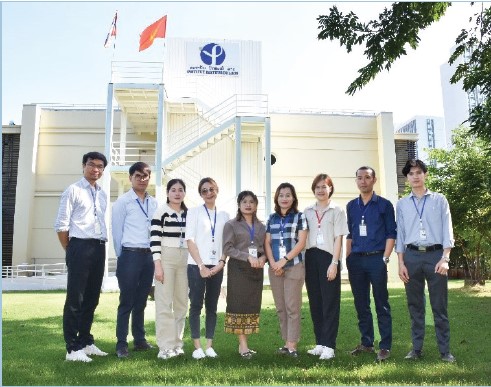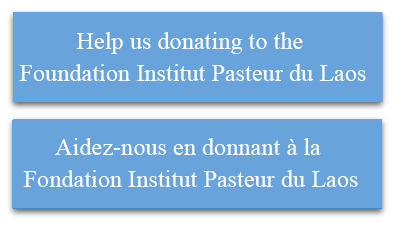Medical Entomology & Biology of Disease Vectors 2023

From the left: Khamsing, Nothasine, Yodkeo, Phonesavanh, Somphat, Vaekey, Somsanith, Khaithong, Tiger.
The Medical Entomology and Vector-borne Diseases Laboratory at the Institut Pasteur du Laos is one of the most active medical entomology laboratories in Laos as well as in Southeast Asia. In order to identify common and emerging vector-borne pathogens in Laos, the medical entomology lab has established studies to assess the distribution and infection potential of various arthropod vectors such as ticks, chigger mites, mosquitoes, sandflies, bat flies, etc. Our lab uses different approaches for taxonomic studies of arthropod vectors, in particular combination of traditional morphological taxonomy and modern molecular techniques. Both known and unknown pathogens related to arthropods are also investigated by a molecular technique using pan-genus and by Next Generation Sequencing in collaboration with different collaborators.
In order to build sustainable local capacity in Laos to investigate and respond to vector-borne diseases as well as other emerging zoonotic viral diseases, our laboratory has also provided on the job training to our local collaborators such as officers of the Lao Army Institute for Disease Prevention, as well as students from the National University of Laos.
Team:
Head of Laboratory.
Dr. Khamsing Vongphayloth, MD.
Research Engineer.
Mrs. Somsanith Chonephetsarath.
Mr. Nothasine Phommavanh.
Laboratory technician.
Ms. Phonesavanh Luangamath.
Mr. Khaithong Lakeomany.
Mrs. Somphat Nilaxay.
Mrs. Vaekey Vungkyly.
Trainee.
Mr. Tavun Pongsanarm.
Dr. Tiger Soulaphy.
Executive summary
Vector-borne diseases constitute a significant infectious disease risk for populations. Because of limitations in diagnostic tools availability for efficient surveillance, vector-borne diseases are often under-recognized in low income countries like Laos.
Ectoparasites and Pathogens Surveillance in Laos
Ectoparasite and pathogens studies in Laos have been initiated in 2014 in order to assess the distribution of ticks and other ectoparasites such as chigger mites and their related pathogens (arboviruses and rickettsia) by using molecular methods (PCRs and Next Generation Sequencing). In 2023, the team conducted several field collection campaigns in the provinces of Borlikhamxay and Phongsaly. A total of 3,621 ticks and other ectoparasites were collected. Ticks were classified into 15 species and 5 genera. PCR on the 17KDa gene of rickettsia showed tested positive in 2/177 and 18/177 pools of chigger mites and ticks respectively. So far, no sample tested positive for flaviviruses and phleboviruses using classical RT-PCR methods. However, results from NGS demonstrated a high diversity of arboviruses among tick samples. A detailed analysis of these data is ongoing.
Mapping of Sandfly vectors and their related pathogens in Laos.
Interest in Phlebotomine sandflies from Southeast Asia increased since the first autochthonous human case of leishmaniasis was reported in Thailand in 1996. Nothing is known about sandflies and sandfly-related pathogens in Laos. The aim of this project is to inventory the sandfly species using morphological and molecular techniques and to detect their related putative pathogens (arboviruses and leishmania) by using molecular methods (PCRs and Next Generation Sequencing). Sandflies were morphologically classified into 26 species and 5 genera.
Hematophagous insects and ectoparasites in karstic cave areas and their related pathogens in Laos.
In a collaboration between Lao young medical entomologists from IPL and officers of the Lao Army Institute for Disease Prevention, a study on hematophagous insects and ectoparasites in karstic cave areas and their related pathogens in Laos was conducted. This study aimed at characterizing the arboviruses associated with different arthropod vectors including mosquitoes, sandflies, culicids, ticks and chigger mites in karstic cave ecosystems in Laos where the knowledge on vectors and pathogens is very limited. Field collection campaigns were carried out in Khammouane and Vientiane provinces. Arthropod insects were morphologically identified and then tested for the presence of three main arbovirus groups including flaviviruses, alphaviruses and phleboviruses by RT-PCR. So far, a total of 2,224 arthropods have been collected, and now identification and pathogen screening of these samples is ongoing.
Plain language summary.
During the recent decades, diseases transmitted by insects have become important public health problems.
Ectoparasites such as ticks and chigger mites, are parasites that live on the outside of their hosts. They have been known as vectors of microbes that cause diseases in humans and animals. In order to assess the distribution of ectoparasite vectors and the microbes that they are able to transmit such as arboviruses (viruses transmitted by arthropods, including mosquitoes) and rickettsia (bacteria living inside human and animal cells) in Laos, the entomologists of IPL conducted field collections in two provinces of Laos in 2023. The ectoparasites were identified based on their morphology and their related pathogens were analyzed by molecular techniques. Our preliminary results showed that at least 15 tick species were identified and various arboviruses were detected from these tick samples. In addition, rickettsia species were also detected from ticks and chigger mites. Specific identification of these viruses and bacteria is now ongoing. We will continue our study in other sites in 2024 in order to better understand the distribution of these ectoparasite vectors and their related pathogens.
Mapping of Sandfly vectors and their related pathogens in Laos.
Phlebotomine sandflies are tiny arthropod hematophagous insects that have been known as vectors of arboviruses, leishmania parasites and bacteria. Before 1996, Southeast Asia was considered a free region for leishmaniasis, so the knowledge of sandflies and their related pathogens in this region is very limited. Since the first autochthonous human case of leishmaniasis was reported in Thailand in 1996, interest in Phlebotomine sandflies from Southeast Asia increased, especially in Thailand. However, nearly nothing is known about sandflies and their related pathogens in Laos. So, our objective is to inventory sandfly species in Laos using morphological and molecular identification, and also screen them for pathogens such as phlebovirus and leishmania by molecular techniques. More than 20 species of sandflies were found during our study. While our lab screening for arboviruses is ongoing, no leishmania DNA has been detected so far. However, we found that 13 sandfly samples were positive for the parasite name Trypanosoma spp. The pathogenicity of these Trypanosoma spp. to animals or humans is still unknown. In order to better understand sandflies and their related pathogens in Laos, we will continue our study in 2024.
Hematophagous insects and ectoparasites in karstic cave areas and their related pathogens in Laos.
In a particular environmental condition, some pathogens (microbes causing diseases) may jump from one species (human or animal) to another species and cause a new disease. In order to better understand the role of bloodsucking arthropods in karstic cave areas and their related pathogens as well as to build sustainable local capacity, Lao young medical entomologists from IPL and Lao Army Institute for Disease Prevention have conducted a study aiming at investigating the arboviruses present in different arthropod vectors including mosquitoes, sandflies, culicoides, ticks and chigger mites in karstic cave ecosystems in Laos. Field collections were carried out from the Khammuane and Vientiane provinces. Mosquitoes, sandflies, culicids, ticks and chigger mites were morphologically identified and then used for virus screening using molecular techniques. Our study is still ongoing and expect that the results of this project will yield a clearer picture of the risk of exposure to insect vectors in karstic and cave areas in Laos.
Project carried on in the lab:
+Ectoparasites and pathogen surveillance in Laos.
+Mapping of Sandfly vectors and their related pathogens in Laos.
+Hematophagous insects and ectoparasites in karstic cave areas and their related pathogens in Laos.






